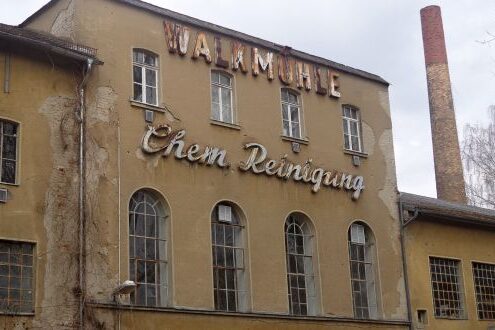Artists' Association Walkmühle e.V.
The former Walkmühle, which was built to finance the Wiesbaden orphanage at the beginning of the 18th century, is now home to the Walkmühle Artists' Association. It organizes art exhibitions here, as well as concerts, lectures and readings. In 2011, the artists' association was awarded the Wiesbaden Culture Prize.
The Walkmühle, one of the last unrenovated historical industrial monuments in Wiesbaden, offers ample space for creative work. The artists' association Walkmühle e. V., founded in 2005 as a merger of the two associations Kunst + Raum Wiesbaden e.V. and Verein Walkmühle e. V., runs a diverse cultural program there and submitted a professional renovation and usage concept to the city of Wiesbaden back in 2009. This outlined how the project's existence could be secured, the property developed and the Walkmühle expanded into a center of cultural life with mixed use of culture, commerce and housing in the Rhine-Main region. By resolution of the city council on May 23, 2013, the refurbishment and letting of the facility was transferred to the city-owned Wiesbadener Immobilien Management GmbH (WIM), thereby achieving a first important goal.
The fulling mill was built in 1736/1737 at the instigation of Pastor Egidius Günther Hellmund. The rents from the associated craft businesses that used the water power were primarily intended to finance the orphanage founded by Hellmund and built near the Mauritius Church in 1723. In 1810, the fulling mill was auctioned off and converted into a restaurant, which was given a dance hall in 1811. The water mill continued to supply energy for leather rolling, hemp processing and weapon grinding. From 1867, the Walkmühl brewery operated here, which removed the mill building and constructed a larger building complex with extensive, ornate brick-built cellars in its place. In the 1920s, the dye works, laundry and dry-cleaning business began in the Walkmühle. After the city bought the site in 1966, ZDF, which was still based at Unter den Eichen in Wiesbaden at the time, used the Walkmühle for offices and storage space from the end of the 1960s.
At the end of the 1980s, artists moved into the Walkmühle and, as pioneers, renovated rooms at their own expense and converted them into studios, thus establishing the property on the outskirts of the city as a cultural location. At the beginning of the 1990s, they joined forces with architects to form the Walkmühle e.V. association, developed a utilization and renovation concept and obtained listed building status. This work was given new impetus in 2005 with the founding of the Walkmühle e.V. artists' association.
Since 2003, events at the Walkmühle have become an integral part of the city's cultural life. Art enthusiasts from Wiesbaden and guests from outside the city have attended the events, which have featured over 600 artists to date (as of 2013). In addition to concerts, lectures, readings, theater performances and discussions, the large thematic exhibitions are particularly noteworthy. The exhibitions curated by artists not only impress with their professional presentations in the historical ambience of the industrial monument, but also with the combination of works by unknown and established artists. The supra-regional media presence, the increasing number of supporting members and the growing mailing list are proof of the project's lasting impact.
In 2011, the Walkmühle Artists' Association received the Cultural Award of the State Capital of Wiesbaden and in 2012, the association hosted the art-historically significant exhibition "reliefreduktiv", its one hundredth event.
In 2013, the city council finally decided to provide the necessary funding for the upcoming extensive renovation work and Wiesbadener Immobilien Management (WIM) Liegenschaftsfonds GmbH became the owner of the property. It is responsible for the refurbishment, which is due to be completed by the end of 2017.
Literature
Monument topography of the Federal Republic of Germany. Cultural monuments in Hesse. Wiesbaden I.1 - 3, edited by Sigrid Russ, Stuttgart 2005. (I.3, pp. 808-814)

